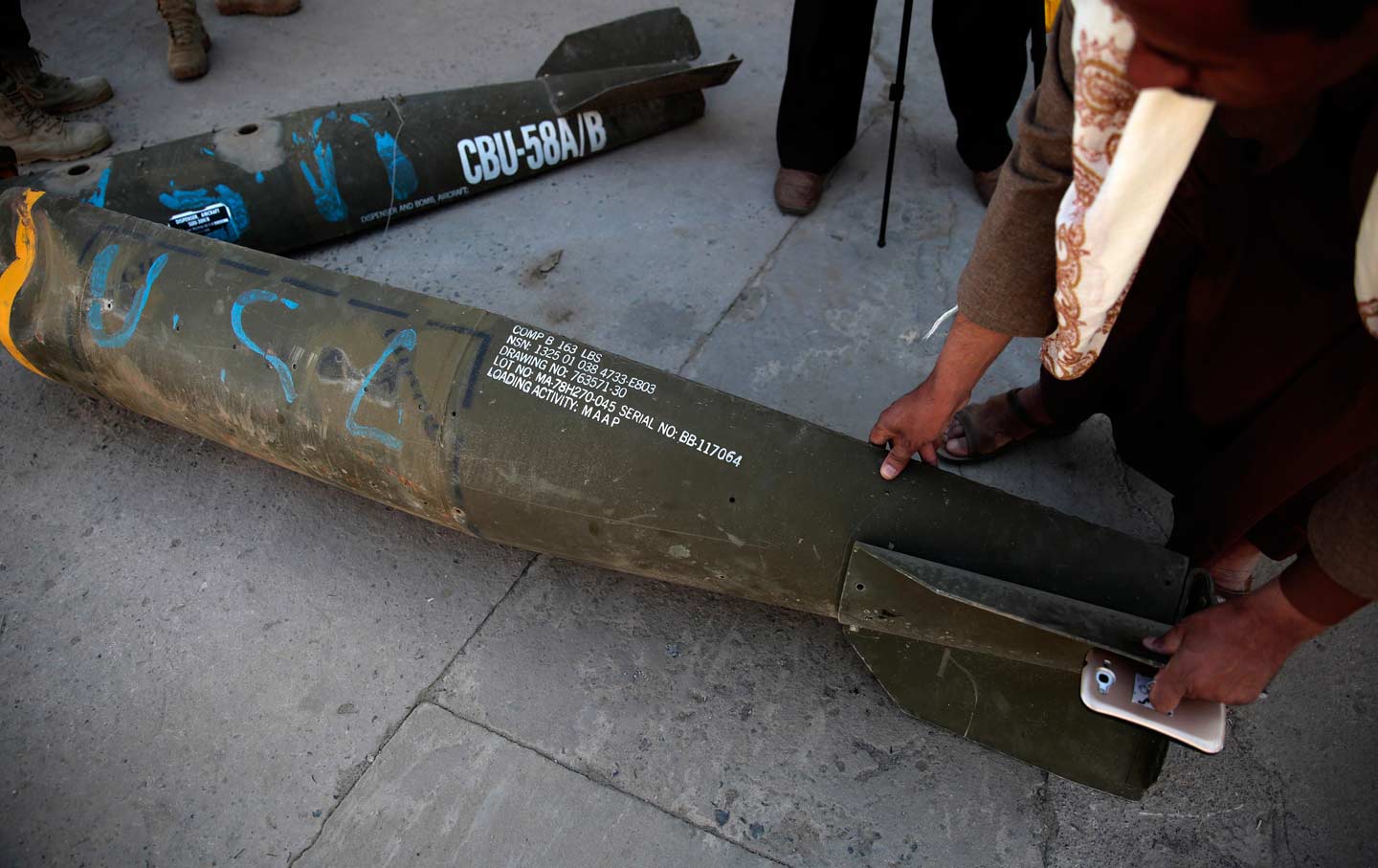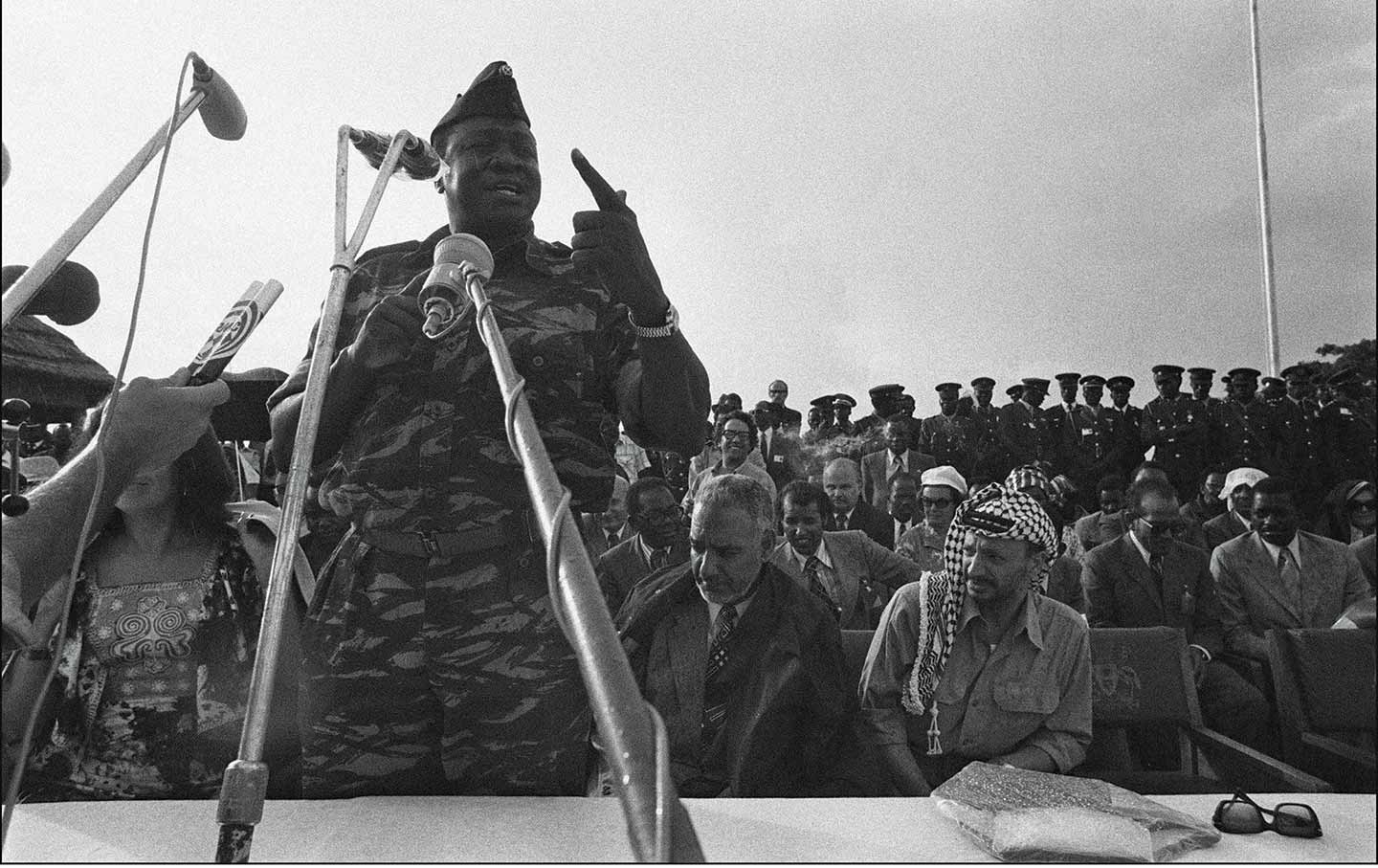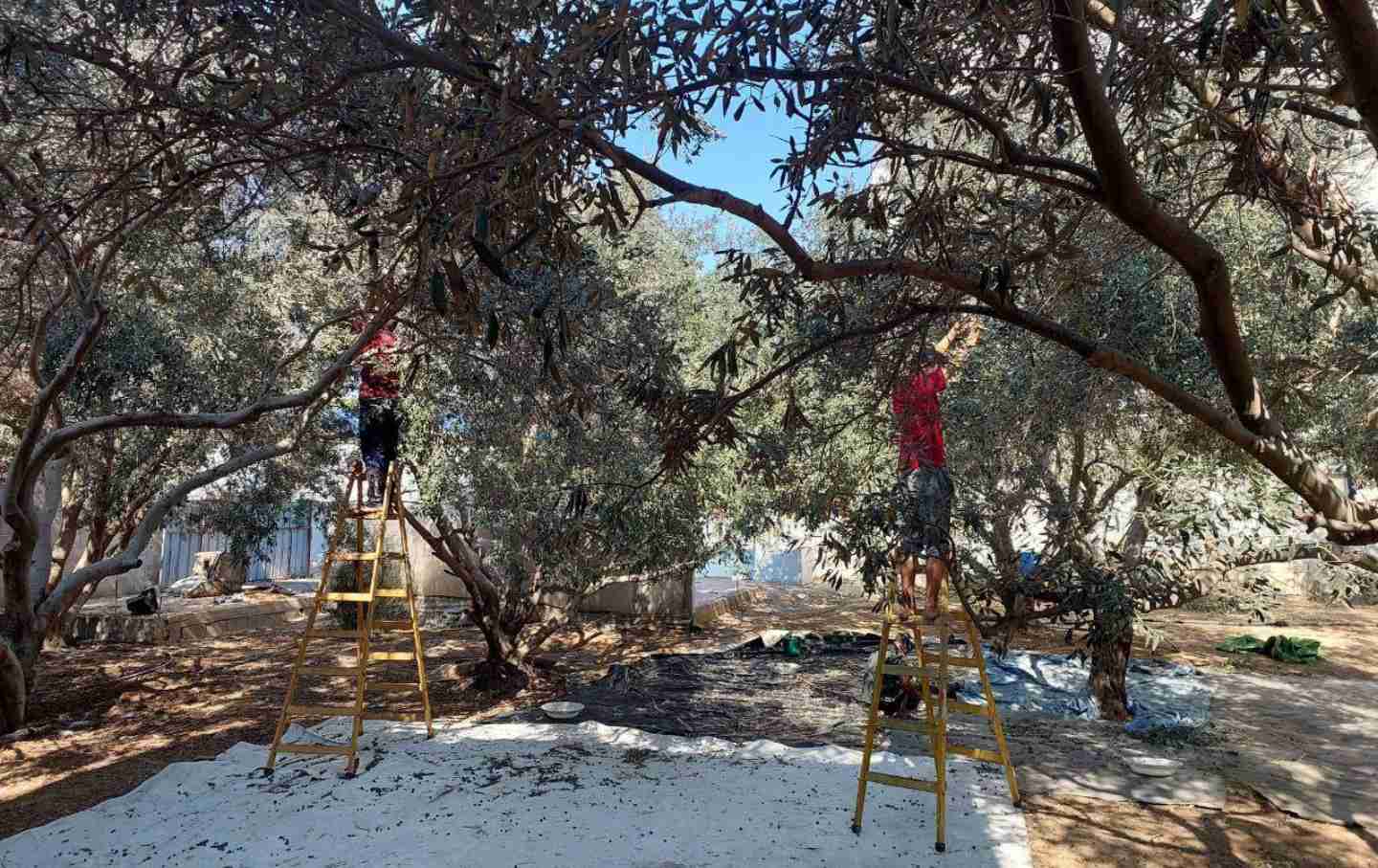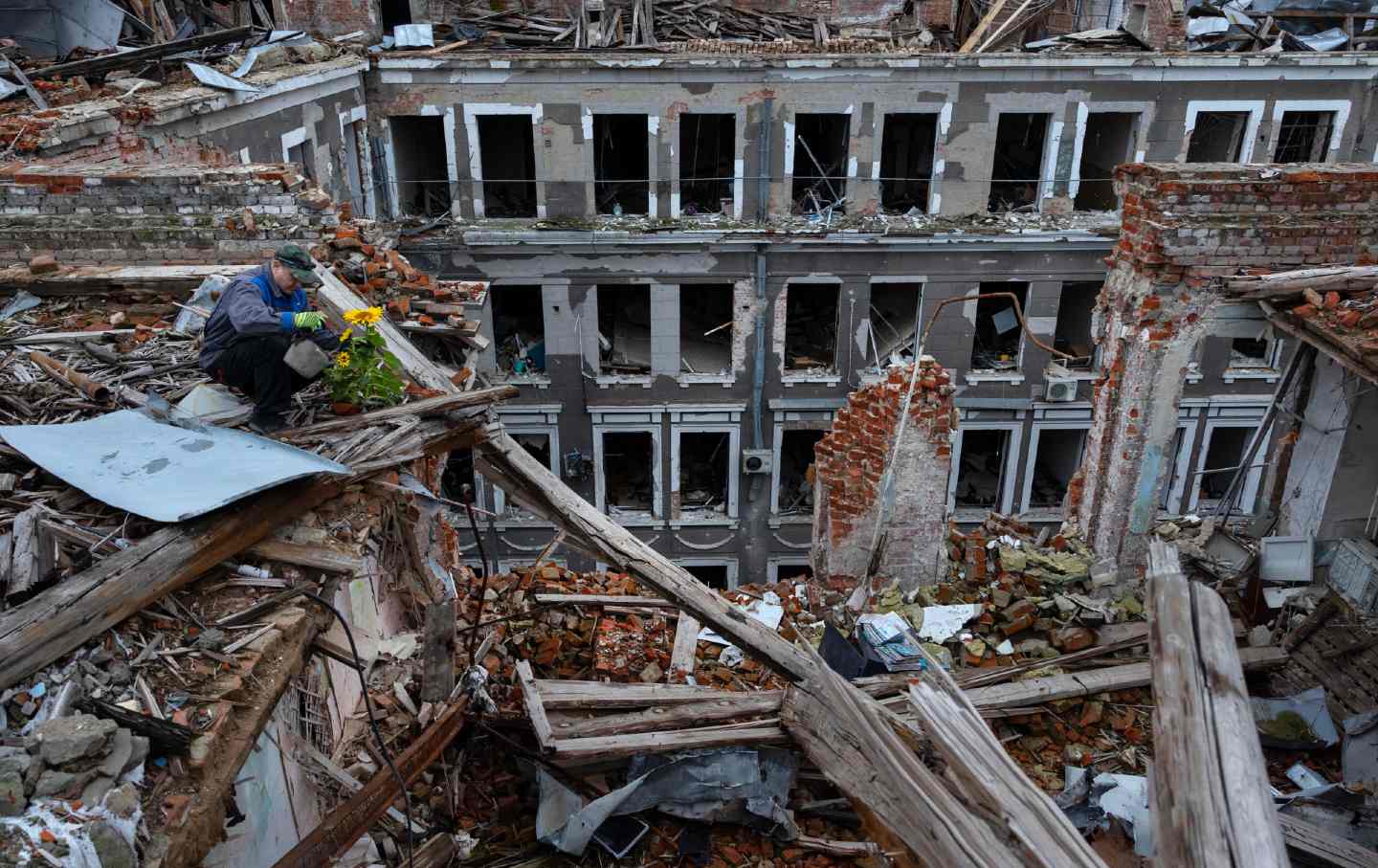The Remnants of War Are Killing People in Times of Peace
Unexploded ordnance makes the terror of war linger after the wars themselves are in the history books.

A Yemeni man displays an American-made cluster bomb at a police compound in Sanaa, Yemen, 2016.
(AP / Hani Mohammed)
This article originally appeared at TomDispatch.com. To stay on top of important articles like these, sign up to receive the latest updates from TomDispatch.com.
Count on one thing: Armed conflict lasts for decades after battles end and its effects ripple thousands of miles beyond actual battlefields. This has been true of America’s post-9/11 forever wars that, in some minimalist fashion, continue in all too many countries around the world. Yet those wars, which we ignited in Afghanistan, Iraq, and Pakistan in the wake of the 9/11 attacks, are hardly the first to offer such lessons. Prior wars left us plenty to learn from that could have led this country to respond differently after that September day when terrorists crashed planes into the World Trade Center in New York City and the Pentagon in Washington, DC. Instead, we ignored history and, as a result, among so many other horrific things, left our weaponry—explosives, small arms, you name it—in war zones to kill and maim yet more people there for generations to come.
Case in point: We Americans tend to disregard the possibility (however modest) that weapons of war could even destroy our own lives here at home, despite how many of us own destructive weaponry. A few years ago, my military spouse and I were looking for a house for our family to settle in after over a decade of moving from military post to military post. We very nearly bought an old farmhouse owned by a combat veteran who mentioned his deployments to Afghanistan and Iraq. We felt uncertain about the structure of his house, so we arranged to return with our children to take another look after he had moved out. The moment we entered the garage with our two toddlers in tow, we noticed a semiautomatic rifle leaning against the wall, its barrel pointing up. Had we not grabbed our son by the hand, he might have run over to touch it and, had it been loaded, the unthinkable might have occurred. Anyone who has raised young children knows that a single item in an empty room, especially one as storied as a gun (in today’s age of constant school shootings and lockdowns) could be a temptation too great to resist.
That incident haunts me still. The combat vet, who thought to remove every item from his home but a rifle, left on display for us, was at best careless, at worst provocative, and definitely weird in the most modern meaning of that word. Given the high rates of gun ownership among today’s veterans, it’s not a coincidence that he had one, nor would it have been unknown for a child (in this case mine) to be wounded or die from an accidental gunshot. Many times more kids here die that way, whether accidentally or all too often purposely, than do our police or military in combat. Boys and men especially tend to be tactile learners. Those of them in our former war zones are also the ones still most likely to fall victim to mines and unexploded ordnance left behind, just as they’re more likely to die here from accidental wounds.
Scenes not that different from the one I described have been happening in nearly 70 countries on a regular basis, only with deadlier endings. Hundreds of people each year—many of them kids—happen upon weapons or explosives left over from wars once fought in their countries and are killed, even though they may have been unaware of the risks they faced just seconds before impact. And for that, you can thank the major warmakers on this planet like the United States and Russia that have simply refused to learn the lessons of history.
A Deadly Glossary
Many kinds of explosives linger after battles end. Such unexploded ordnance (UXO) includes shells, grenades, mortars, rockets, air-dropped bombs, and cluster munition bomblets that didn’t explode when first used. Among the most destructive of them are those cluster munitions, which can spread over areas several football fields wide, often explode in mid-air, and are designed to set objects on fire on impact. Militaries (ours among them) have been known to leave behind significant stockpiles of such explosive ordnance when conflicts cease. Weapons experts refer to such abandoned ordnance as AXO and it’s not uncommon for militaries to have stored and then abandoned them in places like occupied schools.
Close cousins of UXO are landmines designed to explode and kill indiscriminately upon contact, piercing tanks and other vehicles, as well as what came to be known as Improvised Explosive Devices (IEDs), jerry-rigged homemade bombs often buried in the ground, that kill on impact. IEDs gained notoriety during the American wars in Afghanistan and Iraq, where they accounted for more than half of reported US troop casualties. And both unexploded landmines and IEDs can do terrible damage years later in peacetime.
As many of us are aware, long before this century’s American-led wars on terror started, militaries had already established just such a deadly legacy through their use of unexploded ordnance and mines. In Cambodia, which the United States bombed heavily during the Vietnam War in the 1960s and early 1970s, about 650 square kilometers remain contaminated with cluster-munition remnants from American aerial attacks, while a still larger area contains landmines. It’s estimated, in fact, that leftover landmines and other exploding ordnance killed nearly 20,000 Cambodians in what passed for “peacetime” between 1979 and 2022, also giving that country the dubious distinction of having one of the highest number of amputees per capita on the planet. Likewise, half a century after the US littered neighboring Laos with cluster bombs, making it, per capita, the most bombed country in the world, less than 10 percent of its affected land has been cleared.
Similarly, dud bomblets, which failed to detonate in mid-air, are estimated to have killed or maimed somewhere between 56,000 and 86,000 civilians globally since Hitler’s air force first tested them out on Spanish towns during that country’s civil war in the 1930s. Despite concerted international advocacy by governments and human rights groups beginning in the 2000s, hundreds of new cluster munition casualties are reported yearly. In 2023, the most recent year on record globally, 93 percent of cluster munition casualties were civilians, with 47 percent of those killed and injured by such remnant explosives children.
Cluster munitions are known for killing broadly on impact, so it’s not easy to get firsthand accounts of just what it’s like to witness such an attack, but a few such unflinching accounts are available to us. Take for instance, a report by Human Rights Watch researchers who interviewed survivors of a Russian cluster munitions attack in the eastern Ukrainian village of Hlynske in May 2022. As one man reported, after hearing a rocket strike near his home, “Suddenly I heard my father screaming, ‘I’ve been hit! I can’t move,’ he said. I ran back and saw that he had fallen on his knees but couldn’t move from the waist down, and there were many metal pieces in him, including one sticking out of his spine and another in his chest. He had these small metal pellets lodged in his hands and legs.”
According to the report, his father died a month later, despite surgery.
How did a noise outside that survivor’s home so quickly become shrapnel lodged in his father’s body? Maybe someone growing up in America’s poorer neighborhoods, littered with weapons of war, can relate, but I read accounts like his and realize how distant people like me normally remain from war’s violence.
After the international Cluster Munitions Convention took effect in 2010, 124 countries committed to retiring their stockpiles. But neither the US, Russia, nor Ukraine, among other countries, signed that document, although our government did promise to try to replace the Pentagon’s cluster munitions with variants that supposedly have lower “dud” rates. (The US military has not explained how they determined that was so.)
Our involvement in the Ukraine war marked a turning point. In mid-2023, the Biden administration ordered the transfer of cluster munitions from its outdated stockpile, sidestepping federal rules limiting such transfers of weapons with high dud rates. As a result, we added to the barrage of Russian cluster-munition attacks on Ukrainian towns. New cluster-munition attacks initiated in Ukraine have created what can only be seen as a deadly kind of time bomb. If it can be said that the US and Russia in any way acted together, it was in placing millions of new time bombs in Ukrainian soil in their quest to take or protect territory there, ensuring a future of mortal danger for so many Ukrainians, no matter who wins the present war.
Afghanistan, Every Step You Take
At the Costs of War Project, which I helped found at Brown University in 2010, a key goal continues to be to show how armed conflict disrupts human lives, undermining so much of what people need to do to work, travel, study, or even go to the doctor. Afghanistan is a case in point: An area roughly 10 times the size of Washington, DC, is now thoroughly contaminated by mines and unexploded ordnance. Prior to the US attack in 2001, Afghans already had to contend with explosives from the Soviet Union’s disastrous war there in the 1980s. And I’m sure you won’t be surprised to learn that casualties from that war’s unexploded ordnance and mines only rose after the US-led invasion further unsettled the country. It’s estimated that well over half of that country’s 20,000 or so injuries and deaths between 2001 and 2018 were due to unexploded ordnance, landmines, and other explosive remnants of war like IEDs. Contaminated Afghan land includes fields commonly used for growing food and letting livestock graze, schools, roads, tourist sites, and former military bases and training ranges used by the US and its NATO allies.
Worse yet, the damage isn’t only physical. It’s also psychological. As Costs of War researchers Suzanne Fiederlein and SaraJane Rzegocki have written, “The fear of being harmed by these weapons [unexploded ordnance] is magnified by knowing or seeing someone injured or killed.” In her ethnography of Afghan war widows, Anila Daulatzai offered a gripping illustration of how loss, death, and psychological terror ripple outward to a family and community after a young boy dies in a bomb blast on his way to school and his parents turn to heroin to cope.
When I read such accounts, what stands out to me is how long such unexploded ordnance makes the terror of war linger after the wars themselves are in the history books. Think about what life, stressful as it might be in times of peace, would be like if every step you took might be your last because of unseen threats lurking under the ground. That would include threats like certain bomblets, attractive with their bell-like appearance, which your young child might pick up, thinking they’re toys.
Popular
“swipe left below to view more authors”Swipe →The US Arming of Ukraine (“We Start When It All Ends”)
And we still haven’t learned. Today, with 26,000 square kilometers (an area roughly the size of my home state of Maryland) contaminated by mines and unexploded ordnance, Ukraine is the most mined country in the world. I recently spoke with a founding director of the Ukrainian Association for Humanitarian Demining (UAHD), an umbrella organization based in Kyiv and responsible for information-sharing on mines and other unexploded ordnance, as well as future demining, and humanitarian aid based on such an ongoing nightmare.
From our conversation, what stood out to me was how people’s ordinary lives have come to a halt because of this war. For example, much has been written about how interruptions in the Ukrainian grain supply impacted food prices and famine globally, but we pay less attention to how and why. As the UAHD representative told me, “For two years, most Ukrainian farmers in occupied territory have had to halt their work because of mines and unexploded ordnance. This past Thursday, the Ukrainian government issued their first payment so that one day, these farms might be able to keep doing their work.” If the history of Laos is any marker and if the Ukraine war ever ends, just the cleanup will prove a long slog.
When I asked how civilian lives in Ukraine were affected by cluster munitions, the response from the UAHD representative was brief: “I don’t know, because war zones are off-limits to us right now. Once the fighting finally ends, we can survey the land and talk to people living there. We start when it all ends.” My interlocutor’s comments reminded me of a superb recent novel on modern warfare, Andrey Kurkov’s Grey Bees. It focuses on a beekeeper who stays behind in his eastern Ukrainian farming village after his neighbors have evacuated to escape the fighting. The novel conveys the poverty and physical danger war brings with it, as well as how isolated from one another civilians in war zones grow, not least because of the dangers of just moving around along once-quiet fields and roads. For instance, the one gift that a Ukrainian soldier offers the beekeeper in passing is a grenade for his own protection, which he ultimately uses to destroy his bees, nearly hurting himself in the process. His other brush with near-death occurs when a traumatized Ukrainian veteran threatens him with an axe during a flashback to combat. War, in other words, returns home, again and again.
Like the beekeeper, we all need to pay attention to what’s left in the wake of our government’s exploits. We need to ask ourselves what future generations may have to deal with thanks to what our leaders do today in the name of expediency. That’s true when it comes to those horrifying cluster munitions and essentially every other militarized response governments concoct to grapple with complex problems.
In this context, let me suggest that there are two messages readers should take away from this piece: It couldn’t be more important to bear witness to what’s being done to destroy our world and, when the fighting ends, it’s also vital to pay attention to what has been left behind.
Disobey authoritarians, support The Nation
Over the past year you’ve read Nation writers like Elie Mystal, Kaveh Akbar, John Nichols, Joan Walsh, Bryce Covert, Dave Zirin, Jeet Heer, Michael T. Klare, Katha Pollitt, Amy Littlefield, Gregg Gonsalves, and Sasha Abramsky take on the Trump family’s corruption, set the record straight about Robert F. Kennedy Jr.’s catastrophic Make America Healthy Again movement, survey the fallout and human cost of the DOGE wrecking ball, anticipate the Supreme Court’s dangerous antidemocratic rulings, and amplify successful tactics of resistance on the streets and in Congress.
We publish these stories because when members of our communities are being abducted, household debt is climbing, and AI data centers are causing water and electricity shortages, we have a duty as journalists to do all we can to inform the public.
In 2026, our aim is to do more than ever before—but we need your support to make that happen.
Through December 31, a generous donor will match all donations up to $75,000. That means that your contribution will be doubled, dollar for dollar. If we hit the full match, we’ll be starting 2026 with $150,000 to invest in the stories that impact real people’s lives—the kinds of stories that billionaire-owned, corporate-backed outlets aren’t covering.
With your support, our team will publish major stories that the president and his allies won’t want you to read. We’ll cover the emerging military-tech industrial complex and matters of war, peace, and surveillance, as well as the affordability crisis, hunger, housing, healthcare, the environment, attacks on reproductive rights, and much more. At the same time, we’ll imagine alternatives to Trumpian rule and uplift efforts to create a better world, here and now.
While your gift has twice the impact, I’m asking you to support The Nation with a donation today. You’ll empower the journalists, editors, and fact-checkers best equipped to hold this authoritarian administration to account.
I hope you won’t miss this moment—donate to The Nation today.
Onward,
Katrina vanden Heuvel
Editor and publisher, The Nation








